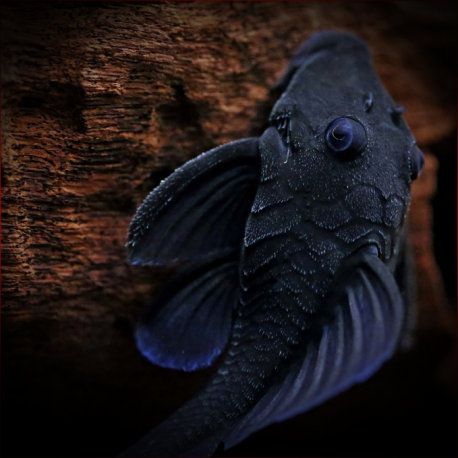More info
Datasheet
| Minimum Tank Size | 72 litres / 19.02 US gallons |
| Maximum Size | 8.1cm / 3.19inches |
| Temperature | 26°C / 78.80°F - 30°C / 86.00°F |
| Hardness | 1.01dgH / 18ppm - 10.03dgH / 179ppm |
| pH | 5.5-7.5 |
General Description
Baryancistrus beggini, commonly known as Blue 'Panaque' or L239, is a species belonging to the Loricariidae family within the order Siluriformes. It is a relatively small fish species, with individuals reaching a maximum size of around 8.1cm. This species is characterized by its uniformly black to brownish body and fin coloration with a turquoise to bluish sheen, along with the distinctive keel formed by midventral body plates 3-5.
Aquarium Setup
The ideal tank setup for Baryancistrus beggini should mimic a flowing river environment, with a substrate of rocks, gravel, and large boulders. Addition of driftwood, branches, roots, and tough aquatic plants like Microsorum, Bolbitis, or Anubias spp. is recommended. Bright lighting promotes aufwuchs growth, which serves as a natural food source. Clean water, dissolved oxygen, and water movement are crucial, necessitating quality filtration and regular 40-70% water changes.
Behaviour
Blue 'Panaque' is relatively peaceful but not suitable for a typical community aquarium due to its delicate nature. It can be housed alone or with small characids to avoid competition for food or territory. The species displays territorial behavior with conspecifics and similar-looking species, especially among males. While territorial, multiple Baryancistrus beggini individuals can usually coexist in appropriate setups.
Feeding and Diet
In the wild, this species primarily feeds on periphyton and associated microorganisms. In captivity, their diet should consist of high-quality sinking dried foods with added vegetable content, live or frozen bloodworms, mosquito larvae, and occasional defrosted prawns or shrimp. Home-made gelatine-bound recipes with a mix of fish food, shellfish, fruits, and vegetables are beneficial. Due to potential post-importation health issues, these fish may require multiple daily meals initially.
Reproduction & Dimorphism
Baryancistrus beggini is a cave-spawning species where the male guards and tends to the eggs after the female is ejected post-spawning. Adult males exhibit longer odontotes on opercles and pectoral-fin spines, along with potentially enhanced blue pigmentation. Sexually mature females typically have a wider body compared to males, especially evident when gravid.
Habitat and Distribution
This species is known to inhabit areas near the confluence of the río Ventauri with the río Orinoco in Amazonas state, Venezuela, as well as the lower río Guaviare in Colombia. They are found in spaces between granite bedrock and boulders alongside other loricariid species like Acanthicus hystrix, Ancistrus macrophthalmus, and various Hypancistrus and Pseudancistrus species.
Etymology
The genus name Baryancistrus is derived from the Greek word barys, meaning 'heavy', combined with the generic name Ancistrus. The species epithet beggini honors Chris Beggin for his contributions to research, ethical ornamental fish business practices, and professional development within the field.

